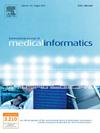使用低成本脑电图设备进行压力监测:系统的文献综述
IF 3.7
2区 医学
Q2 COMPUTER SCIENCE, INFORMATION SYSTEMS
International Journal of Medical Informatics
Pub Date : 2025-03-06
DOI:10.1016/j.ijmedinf.2025.105859
引用次数: 0
摘要
在包括压力研究在内的心理健康研究中,使用低成本、消费级可穿戴健康监测设备变得越来越普遍。虽然皮质醇反应强度仍然是压力评估的黄金标准,但越来越多的研究机构采用低成本的脑电图设备作为记录生物标志物数据的主要工具,通常与手腕和戒指可穿戴设备相结合。然而,低成本EEG设备之间的技术差异,特别是在传感器数量和根据10-20电极放置系统的放置方面,对研究结果的可重复性提出了挑战。目的综述了低成本脑电图设备和机器学习技术在脑功能评估中的应用,重点介绍了压力检测。它还强调了应力研究中常用的各种机器学习方法的优缺点,并评估了报告结果的可重复性以及传感器数量和放置重要性。方法对已发表的利用脑电图设备进行应力检测及其相关机器学习方法的研究进行全面回顾。在Scopus、b谷歌Scholar、ScienceDirect、Nature和PubMed等数据库中进行搜索,产生69篇相关文章进行分析。选定的研究被综合为四个主题类别:使用EEG的应力评估,低成本EEG设备,基于EEG的应力测量数据集,以及基于EEG的应力分析机器学习技术。对于以机器学习为重点的研究,对验证和可重复性方法进行了严格评估。使用IJMEDI检查表对研究质量进行评估和评分。该综述确定了几项使用低成本脑电图设备监测压力和放松阶段大脑活动的研究,其中许多研究报告使用各种机器学习验证技术具有很高的预测准确性。然而,只有54%的研究在实验前进行了健康筛查,58%的研究由于样本量有限而被归类为低功率研究。此外,很少有研究使用独立验证集或皮质醇反应作为相关生物标志物来验证他们的结果,并且在数据预处理和传感器放置作为提高模型泛化和准确性的关键因素方面缺乏共识。结论低成本的消费级可穿戴设备,包括脑电图和基于手腕的监视器,越来越多地用于与压力相关的研究,为无创生物标志物监测提供了有前途的途径。然而,在标准化脑电信号处理和传感器放置方面仍然存在重大差距,这两者对于提高模型的泛化和准确性至关重要。此外,独立验证集和皮质醇反应作为相关生物标志物的有限使用突出了对更可靠的验证方法的需求。未来的研究应侧重于解决这些限制,并在数据预处理技术和传感器配置方面建立共识,以提高这一不断发展的领域的研究结果的可靠性和可重复性。本文章由计算机程序翻译,如有差异,请以英文原文为准。

Stress monitoring using low-cost electroencephalogram devices: A systematic literature review
Introduction
The use of low-cost, consumer-grade wearable health monitoring devices has become increasingly prevalent in mental health research, including stress studies. While cortisol response magnitude remains the gold standard for stress assessment, an expanding body of research employs low-cost EEG devices as primary tools for recording biomarker data, often combined with wrist and ring-based wearables. However, the technical variability among low-cost EEG devices, particularly in sensor count and placement according to the 10-20 Electrode Placement System, poses challenges for reproducibility in study outcomes.
Objective
This review aims to provide an overview of the growing application of low-cost EEG devices and machine learning techniques for assessing brain function, with a focus on stress detection. It also highlights the strengths and weaknesses of various machine learning methods commonly used in stress research, and evaluates the reproducibility of reported findings along with sensor count and placement importance.
Methods
A comprehensive review was conducted of published studies utilizing EEG devices for stress detection and their associated machine learning approaches. Searches were performed across databases including Scopus, Google Scholar, ScienceDirect, Nature, and PubMed, yielding 69 relevant articles for analysis. The selected studies were synthesized into four thematic categories: stress assessment using EEG, low-cost EEG devices, datasets for EEG-based stress measurement, and machine learning techniques for EEG-based stress analysis. For machine learning-focused studies, validation and reproducibility methods were critically assessed. Study quality was evaluated and scored using the IJMEDI checklist.
Results
The review identified several studies employing low-cost EEG devices to monitor brain activity during stress and relaxation phases, with many reporting high predictive accuracy using various machine learning validation techniques. However, only 54% of the studies included health screening prior to experimentation, and 58% were categorized as low-powered due to limited sample sizes. Additionally, few studies validated their results using an independent validation set or cortisol response as a correlating biomarker and there was a lack of consensus on data pre-processing and sensor placement as a key contributor to improving model generalization and accuracy.
Conclusion
Low-cost consumer-grade wearable devices, including EEG and wrist-based monitors, are increasingly utilized in stress-related research, offering promising avenues for non-invasive biomarker monitoring. However, significant gaps remain in standardizing EEG signal processing and sensor placement, both of which are critical for enhancing model generalization and accuracy. Furthermore, the limited use of independent validation sets and cortisol response as correlating biomarkers highlights the need for more robust validation methodologies. Future research should focus on addressing these limitations and establishing consensus on data pre-processing techniques and sensor configurations to improve the reliability and reproducibility of findings in this growing field.
求助全文
通过发布文献求助,成功后即可免费获取论文全文。
去求助
来源期刊

International Journal of Medical Informatics
医学-计算机:信息系统
CiteScore
8.90
自引率
4.10%
发文量
217
审稿时长
42 days
期刊介绍:
International Journal of Medical Informatics provides an international medium for dissemination of original results and interpretative reviews concerning the field of medical informatics. The Journal emphasizes the evaluation of systems in healthcare settings.
The scope of journal covers:
Information systems, including national or international registration systems, hospital information systems, departmental and/or physician''s office systems, document handling systems, electronic medical record systems, standardization, systems integration etc.;
Computer-aided medical decision support systems using heuristic, algorithmic and/or statistical methods as exemplified in decision theory, protocol development, artificial intelligence, etc.
Educational computer based programs pertaining to medical informatics or medicine in general;
Organizational, economic, social, clinical impact, ethical and cost-benefit aspects of IT applications in health care.
 求助内容:
求助内容: 应助结果提醒方式:
应助结果提醒方式:


